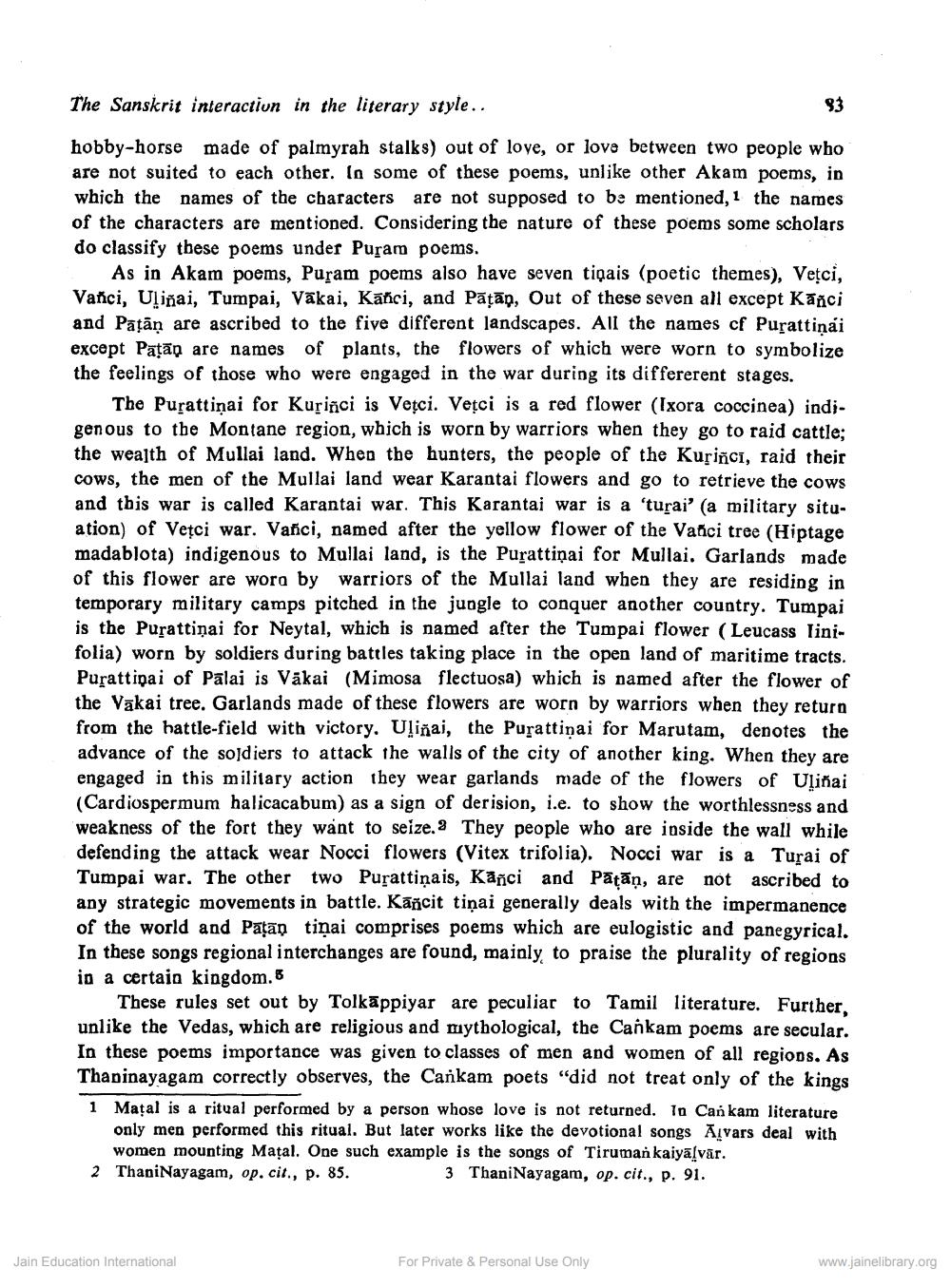________________
The Sanskrit interaction in the literary style..
hobby-horse made of palmyrah stalks) out of love, or love between two people who are not suited to each other. In some of these poems, unlike other Akam poems, in which the names of the characters are not supposed to be mentioned, 1 the names of the characters are mentioned. Considering the nature of these poems some scholars do classify these poems under Puram poems.
As in Akam poems, Puram poems also have seven tiqais (poetic themes), Vetci, Vanci, Uliñai, Tumpai, Vākai, Kāñci, and Pāțāņ, Out of these seven all except Kāñci and Pātān are ascribed to the five different landscapes. All the names of Purattinai except Pațān are names of plants, the flowers of which were worn to symbolize the feelings of those who were engaged in the war during its differerent stages.
The Pusattiņai for Kuriñci is Vetci. Vețci is a red flower (Ixora coccinea) indigenous to the Montane region, which is worn by warriors when they go to raid cattle; the wealth of Mullai land. When the hunters, the people of the Kuriñci, raid their cows, the men of the Mullai land wear Karantai flowers and go to retrieve the cows and this war is called Karantai war. This Karantai war is a 'turai' (a military situation) of Vetci war. Vanci, named after the yellow flower of the Vanci tree (Hiptage madablota) indigenous to Mullai land, is the Purattiņai for Mullai. Garlands made of this flower are worn by warriors of the Mullai land when they are residing in temporary military camps pitched in the jungle to conquer another country. Tumpai is the Purattiņai for Neytal, which is named after the Tumpai flower (Leucass linifolia) worn by soldiers during battles taking place in the open land of maritime tracts. Purattipai of Palai is Vākai (Mimosa flectuosa) which is named after the flower of the Vākai tree. Garlands made of these flowers are worn by warriors when they return from the hattle-field with victory. Uliñai, the Purattiņai for Marutam, denotes the advance of the soldiers to attack the walls of the city of another king. When they are engaged in this military action they wear garlands made of the flowers of Uliñai (Cardiospermum halicacabum) as a sign of derision, i.e. to show the worthlessness and weakness of the fort they want to seize. They people who are inside the wall while defending the attack wear Nocci flowers (Vitex trifolia). Nocci war is a Turai of Tumpai war. The other two Purattiņais, Kāñci and Pāțāņ, are not ascribed to any strategic movements in battle. Kāñcit tiņai generally deals with the impermanence of the world and Paçãn tiņai comprises poems which are eulogistic and panegyrical. In these songs regional interchanges are found, mainly to praise the plurality of regions in a certain kingdom. 8
These rules set out by Tolkāppiyar are peculiar to Tamil literature. Further. unlike the Vedas, which are religious and mythological, the Cankam poems are secular. In these poems importance was given to classes of men and women of all regions. As Thapinayagam correctly observes, the Cankam poets "did not treat only of the kings 1 Matal is a ritual performed by a person whose love is not returned. In Cankam literature
only men performed this ritual. But later works like the devotional songs Aivars deal with
women mounting Matal. One such example is the songs of Tiruman kaiyalvär. 2 ThaniNayagam, op. cit., p. 85.
3 ThaniNayagam, op. cit., p. 91.
Jain Education International
For Private & Personal Use Only
www.jainelibrary.org




